A whippy sapling is trimmed of its branches and head, and bent over. Note the point on the ground which will be directly under the head when the snare is set.
Two strong hooked stakes are driven into the ground about nine inches apart. A cross stick is roughly squared in the centre and placed beneath the two hooks with one of its squared faces directly facing the ground. The bait stick is cut with a cleanly cut faced step, the bottom of the step is on the lower end of the cut. To the top end of the stick the cord from the sapling is tied securely (a clove hitch or stopper hitch is good for this purpose).
One, or better still, two, nooses are run out from the main cord, and held vertically a few inches from the baited end of the stick by thin twigs (not shown). An animal touching the bait disturbs the seated laces, and releases the stepped bait stick which holds the bent sapling. Sensitivity of the release is effected by the ‘grip’ of the seated face of the bait stick.
GROUND SNARE
NICKED BAIT STICK RELEASE
A whippy sapling, lopped of top and branches, has a stout cord tied to its head. The sapling is bent over, and directly beneath the lopped head, a strong hooked stick is driven into the ground. The end of the hooked side is sharpened to a chisel point.
The bait stick is cut with a square nick so that this will engage the chisel edge of the hook. The cord from the head of the sapling is tied to the top end of the nicked bait stick, and the bait is secured on the lower end.
From this cord the noose is tied, and spread a few inches in front of the baited stick.
Fine setting is obtained by making the nick shallow, or for a stubborn release cut the nick deeply.
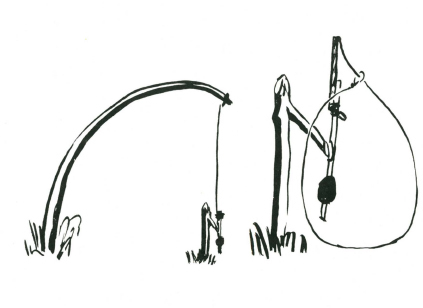
GROUND SNARE
CROSSBAR BAIT SNARE
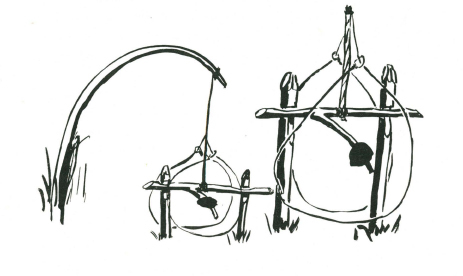
Two stout straight stakes are cut. On the upper end of each a nick is cut, with the straight step on the top end of the stake. The cross bar is now cut, with a side branch so that the end of the side branch is a few inches away from the cross bar. The side farthest away from the side branch is squared on top and sides to fit the squared faces of the stakes. A whippy sapling, lopped of its branches and top, is bent over so that it comes directly above the head of the two stakes driven into the ground. A cord from the head of the sapling is tied to the centre of the cross bar. The side branch is baited, and two nooses are spread either side of the baited crossbar.
Depth of cuts into the two stakes affects the degree of sensitivity of release.
GROUND SNARES
DOUBLE ENDED FIGURE FOUR SNARE
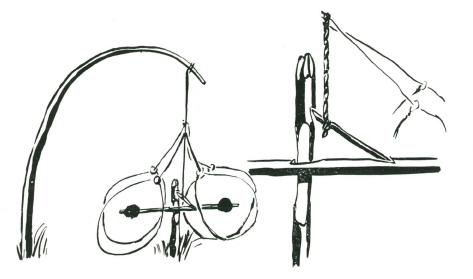
A whippy sapling, trimmed of its branches and head, is bent over and the site directly beneath the head marked on the ground. Before releasing the sapling a stout cord is tied to the head. The three sticks for the release are now cut. One of these is a stake. It must be sharpened at the point, and bevelled at the head. About eight inches from the head two sides are squared off at right angles to each other, and about three inches below the head an undercut nick is made in one of the sides opposite to one of the squared sides.
The crossbar bait stick is now cut. This may be two feet long. In the centre it is nicked or cut to provide a squared step less than one-quarter inch deep. On the end farthest from this step, and at right angles to it, an undercut nick is made. The toggle release stick is now cut. One end is sharpened to a chisel edge, and put in the undercut nick in the stake. The crossbar is placed with its step against the squared edge of the stake, and the undercut nick facing to the top. Mark on the toggle stick where the end should be cut to sit in the upper nick of the crossbar, and sharpen the toggle stick to a chisel point. Tie the free end of the cord from the sapling head to the toggle stick, and then tie on cord for four nooses, and set same in position with forked twigs.
GROUND SNARES
A DOUBLE SPRING SNARE
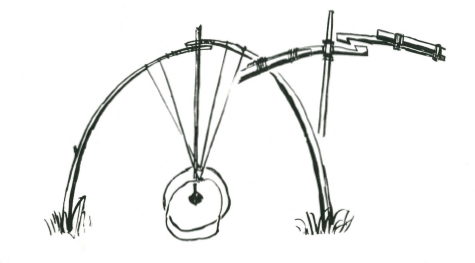
Two saplings are trimmed and bent towards each other. At their heads two interlocking sticks are tied. These sticks are cut so that they step into each other. The bait stick is lashed to one of these, and four cords for the nooses (two onto each sapling head) are lashed.
The snare is set bending the two saplings over, locking the two sticks together, and then setting the nooses, two on each side of the bait, and a few inches distant.
When the animal disturbs the bait, it twists the interlocking sticks, and so releases the two saplings. In springing apart they pull the nooses against each other, and hold the captured animal securely.
GROUND SNARES
TRACK SPRING SNARE
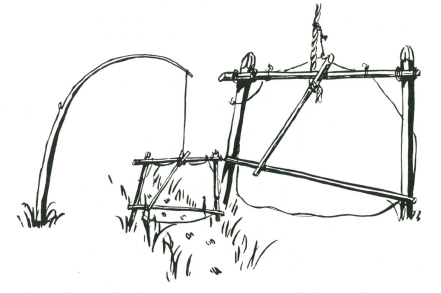
A site is selected on an animal trail where a tall sapling is available a few feet to one side of the track. The sapling is lopped of its branches and top, and a stout cord is tied to the head. Where the bent sapling crosses the trail tall stout pegs are driven well into the ground on either side of the track. To the tops of these stakes a cross bar is securely lashed. There may be occasions when convenient trees will serve instead of stakes.
A stout cord or rope is tied to the head of the sapling and a few feet along the cord a thin strong stick is tied. This stick should nearly reach from the crossbar to the ground. The cord from the sapling is tied a few inches below one end. This end is placed under the crossbar, and the lower end which will now pull forward strongly with the pressure of the bent sapling’s spring, is laid against a thin cross-stick. The noose of the snare is lightly tied to the top crossbar and the stakes to keep it spread open. Release is effected when the animal touches either the bottom stick, knocking it down, or the toggle stick with the cord. Either action will release the holding down of the sapling, and it will spring upright, tightening the noose around the animal's neck.
TREE SNARE
SIMPLE NOOSE FOR TREE CLIMBING ANIMALS
NOTE—This snare is prohibited in many areas, and should not be used unless absolutely necessary, and only where its use is permitted.
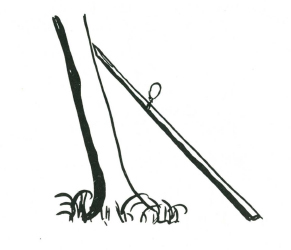
A site is selected by examining a tree which shows the claw marks of tree climbing animals on its bark. The ‘lean’ of the tree is carefully examined, and on the upper side of the ‘lean’ a stout straight pole eight to ten feet long, and at least three or four inches thick is placed to make a ‘path’ for the animal from the ground to well up the tree trunk. The animal will use this pole to climb the tree on its nightly excursions. Onto the upper end of the pole set a simple wire noose, fastened securely to the pole itself.
The animal in climbing or descending the pole will put its head or paw into the noose, and so ensnare itself.
Note.-A point of interest is that most tree living animals will descend a tree if the base of the tree is consistently beaten with a heavy instrument such as the back of an axe or a heavy club. Nocturnal animals will descend a tree in broad daylight, but the blows must be continued and fairly heavy. It is probable that the animal feels the shock through (lie tree and, obeying an impulse to quit before the tree falls, leaves its hiding place. This is an excellent method of getting night feeding animals into daylight for photographing.
TREE SNARES